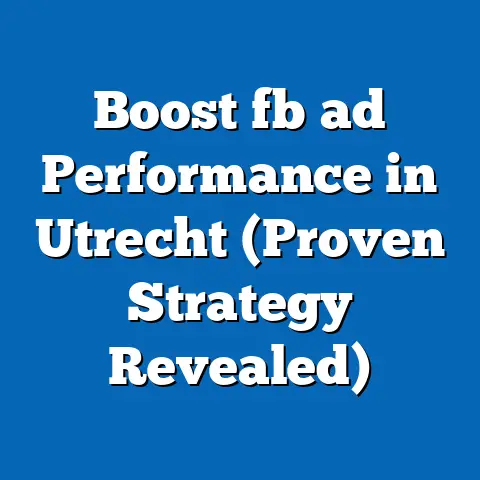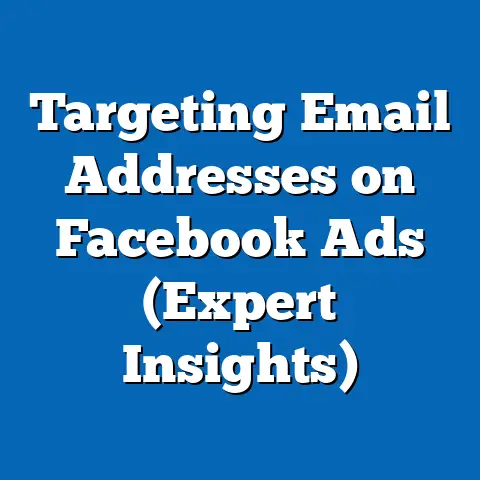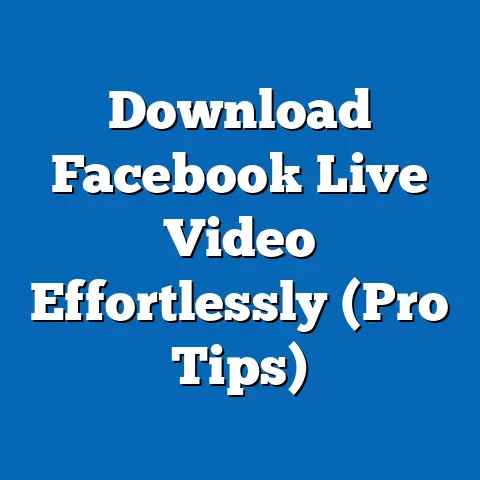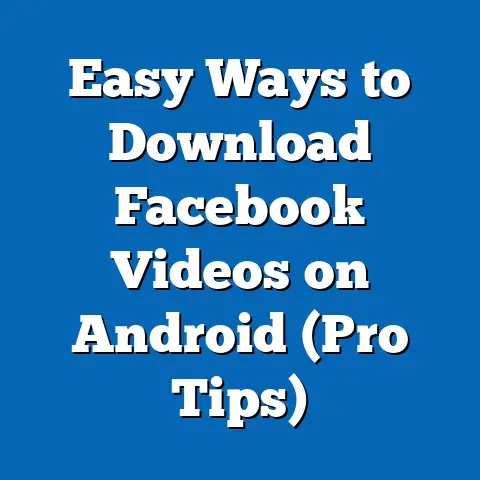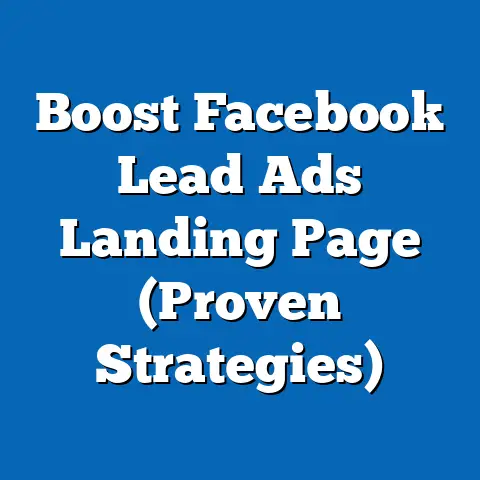Craft Irresistible Facebook Ads for Bands (Expert Strategies)
Imagine this: As the sun sets over a bustling city, the air is filled with the exhilarating sounds of live music. A diverse crowd gathers at a popular venue, the anticipation palpable as fans clutch their drinks, eagerly awaiting the performance of their favorite band. Flashing lights illuminate the stage, and the atmosphere is electric with excitement. What if, just moments before the show, fans received a targeted Facebook ad that not only invites them to the concert but also gives them exclusive backstage access? This is the power of crafting irresistible Facebook ads for bands—a strategic blend of creativity, audience targeting, and digital marketing expertise that can turn casual listeners into die-hard fans.
Facebook advertising can be a game-changer for bands looking to amplify their reach, promote their music, and fill venues. But simply throwing up an ad and hoping for the best won’t cut it. It requires a strategic approach, a deep understanding of your audience, and a creative spark to craft ads that truly resonate.
I’ve spent years helping businesses, including those in the music industry, navigate the ever-evolving landscape of Facebook Ads. I’ve seen firsthand what works, what doesn’t, and how even the smallest tweaks can significantly impact results. In this guide, I’ll share my expert strategies for creating Facebook ads that not only grab attention but also convert potential listeners into loyal fans. Let’s dive in!
Understanding Your Audience: The Foundation of Success
Before you even think about crafting an ad, you need to know who you’re talking to. Understanding your audience is the cornerstone of any successful marketing campaign, and Facebook advertising is no exception. You can’t just assume that everyone who likes music will be interested in your band. You need to dig deeper and identify the specific demographics, interests, and behaviors of your ideal fans.
Think about it: a punk rock band is going to have a vastly different audience than a classical ensemble. And even within those genres, there are nuances. Are you targeting college students, working professionals, or retirees? Are they into specific subgenres, like ska-punk or neo-classical? Do they frequent certain venues or festivals?
Here’s how to get started:
-
Identify Your Core Fanbase: Start by analyzing your existing fans. Who are they? Where do they live? What other bands do they listen to? What are their hobbies and interests? If you have an email list, look at the demographics of your subscribers. If you sell merchandise online, analyze your customer data. This information will provide valuable insights into your core audience.
-
Leverage Facebook Audience Insights: Facebook’s Audience Insights tool is a goldmine of data. It allows you to explore the demographics, interests, and behaviors of people on Facebook. You can use it to research your existing fans or to identify potential new audiences.
- To access Audience Insights, go to Ads Manager and click on “Audience Insights” in the left-hand menu.
- You can then select an audience to analyze: “Everyone on Facebook” or “People connected to your Page.”
- From there, you can filter by demographics (age, gender, location, education, etc.), interests (music genres, bands, hobbies, etc.), and behaviors (purchase activity, device usage, etc.).
-
Create Audience Personas: Once you’ve gathered enough data, create audience personas that represent your ideal fans. A persona is a fictional representation of your target audience, based on research and data. Give your personas names, ages, occupations, and backstories. Describe their interests, motivations, and pain points. The more detailed your personas, the better you’ll be able to tailor your ads to resonate with them.
- For example, you might create a persona named “Sarah,” a 22-year-old college student who loves indie rock and attends local concerts. Or you might create a persona named “Mark,” a 35-year-old working professional who enjoys classic rock and collects vinyl records.
Identify Your Core Fanbase: Start by analyzing your existing fans. Who are they? Where do they live? What other bands do they listen to? What are their hobbies and interests? If you have an email list, look at the demographics of your subscribers. If you sell merchandise online, analyze your customer data. This information will provide valuable insights into your core audience.
Leverage Facebook Audience Insights: Facebook’s Audience Insights tool is a goldmine of data. It allows you to explore the demographics, interests, and behaviors of people on Facebook. You can use it to research your existing fans or to identify potential new audiences.
- To access Audience Insights, go to Ads Manager and click on “Audience Insights” in the left-hand menu.
- You can then select an audience to analyze: “Everyone on Facebook” or “People connected to your Page.”
- From there, you can filter by demographics (age, gender, location, education, etc.), interests (music genres, bands, hobbies, etc.), and behaviors (purchase activity, device usage, etc.).
Create Audience Personas: Once you’ve gathered enough data, create audience personas that represent your ideal fans. A persona is a fictional representation of your target audience, based on research and data. Give your personas names, ages, occupations, and backstories. Describe their interests, motivations, and pain points. The more detailed your personas, the better you’ll be able to tailor your ads to resonate with them.
- For example, you might create a persona named “Sarah,” a 22-year-old college student who loves indie rock and attends local concerts. Or you might create a persona named “Mark,” a 35-year-old working professional who enjoys classic rock and collects vinyl records.
By understanding your audience, you can create ads that speak directly to their needs and interests. This will not only increase your ad engagement but also improve your overall marketing ROI.
Takeaway: Knowing your audience is paramount. Use Facebook Audience Insights and create detailed audience personas to guide your ad creation.
Crafting Compelling Ad Copy: Words That Sing
Now that you know who you’re talking to, it’s time to craft ad copy that grabs their attention and persuades them to take action. Your ad copy is your opportunity to tell your band’s story, highlight your unique selling proposition, and create a connection with your audience.
But in today’s fast-paced digital world, you have mere seconds to capture someone’s attention. Your ad copy needs to be concise, engaging, and relevant. Here are some strategies to help you write ad copy that sings:
-
Grab Attention with a Killer Headline: Your headline is the first thing people will see, so make it count. Use strong verbs, intriguing questions, or surprising statements to pique their curiosity.
- Instead of “Check out our new single,” try “Hear the Song Everyone’s Talking About!”
- Instead of “Concert this Friday,” try “Ready to Rock? We’re Playing This Friday!”
-
Tell a Story: People love stories. Use your ad copy to share your band’s journey, highlight an upcoming event, or explain the inspiration behind your music.
- “From jamming in our garage to headlining local festivals, our journey has been incredible. Join us this Saturday as we celebrate our latest album release!”
-
Highlight Your Unique Selling Proposition (USP): What makes your band different from all the others? Do you have a unique sound? A captivating stage presence? A powerful message? Highlight your USP in your ad copy to stand out from the crowd.
- “Experience the raw energy of [Band Name], the only band blending metalcore with classical violin!”
-
Use a Clear Call to Action (CTA): Tell people exactly what you want them to do. Do you want them to listen to your music? Buy tickets to your show? Visit your website? Use a clear and concise CTA to guide them.
- “Listen Now on Spotify!”
- “Get Your Tickets Before They’re Gone!”
- “Visit Our Website to Learn More!”
-
Keep it Concise: People are bombarded with information every day. Keep your ad copy short and sweet. Get to the point quickly and avoid using jargon or overly complex language.
-
Use Emojis: Emojis can add personality and visual appeal to your ad copy. Use them sparingly and make sure they’re relevant to your message.
- “New Music Alert! 🎶 Check out our latest track on Spotify! 🎧”
Grab Attention with a Killer Headline: Your headline is the first thing people will see, so make it count. Use strong verbs, intriguing questions, or surprising statements to pique their curiosity.
- Instead of “Check out our new single,” try “Hear the Song Everyone’s Talking About!”
- Instead of “Concert this Friday,” try “Ready to Rock? We’re Playing This Friday!”
Tell a Story: People love stories. Use your ad copy to share your band’s journey, highlight an upcoming event, or explain the inspiration behind your music.
- “From jamming in our garage to headlining local festivals, our journey has been incredible. Join us this Saturday as we celebrate our latest album release!”
Highlight Your Unique Selling Proposition (USP): What makes your band different from all the others? Do you have a unique sound? A captivating stage presence? A powerful message? Highlight your USP in your ad copy to stand out from the crowd.
- “Experience the raw energy of [Band Name], the only band blending metalcore with classical violin!”
Use a Clear Call to Action (CTA): Tell people exactly what you want them to do. Do you want them to listen to your music? Buy tickets to your show? Visit your website? Use a clear and concise CTA to guide them.
- “Listen Now on Spotify!”
- “Get Your Tickets Before They’re Gone!”
- “Visit Our Website to Learn More!”
Keep it Concise: People are bombarded with information every day. Keep your ad copy short and sweet. Get to the point quickly and avoid using jargon or overly complex language.
Use Emojis: Emojis can add personality and visual appeal to your ad copy. Use them sparingly and make sure they’re relevant to your message.
- “New Music Alert! 🎶 Check out our latest track on Spotify! 🎧”
Real-World Examples:
-
Example 1 (Local Band Promoting a Show): “🔥 Get ready to rock! [Band Name] is hitting the stage at [Venue] this Friday! 🤘 Expect high-energy anthems and a night you won’t forget. 🎟️ Grab your tickets now before they sell out: [Link]”
-
Example 2 (Band Promoting a New Single): “🎧 Our brand new single, ‘[Song Title],’ is finally here! 🎉 This track is a raw, emotional journey that we poured our hearts into. ❤️ Listen now on Spotify, Apple Music, and more: [Link] What do you think? Let us know in the comments! 👇”
Example 1 (Local Band Promoting a Show): “🔥 Get ready to rock! [Band Name] is hitting the stage at [Venue] this Friday! 🤘 Expect high-energy anthems and a night you won’t forget. 🎟️ Grab your tickets now before they sell out: [Link]”
Example 2 (Band Promoting a New Single): “🎧 Our brand new single, ‘[Song Title],’ is finally here! 🎉 This track is a raw, emotional journey that we poured our hearts into. ❤️ Listen now on Spotify, Apple Music, and more: [Link] What do you think? Let us know in the comments! 👇”
Takeaway: Compelling ad copy is crucial. Use attention-grabbing headlines, tell a story, highlight your USP, and include a clear CTA.
Visual Elements That Captivate: A Picture is Worth a Thousand Clicks
In the visual world of Facebook, your ad’s image or video is often the first thing people notice. High-quality visuals can significantly enhance engagement and drive clicks. It’s not just about having a pretty picture; it’s about using visuals that are relevant, engaging, and aligned with your brand.
Here’s how to create visuals that captivate:
-
Use High-Quality Images and Videos: This is a no-brainer, but it’s worth repeating. Avoid blurry or pixelated images. Invest in professional photography or videography if possible.
-
Showcase Your Band’s Personality: Your visuals should reflect your band’s style and personality. Are you a high-energy rock band? Use action shots from your live performances. Are you a mellow acoustic band? Use warm, intimate images.
-
Use Behind-the-Scenes Footage: People love to see the “real” you. Share behind-the-scenes footage of your band rehearsing, recording, or just hanging out. This can help build a connection with your audience and make them feel like they’re part of your journey.
-
Highlight Live Performances: Videos of your live performances can be incredibly engaging. They give people a taste of what it’s like to see your band in action and can entice them to come to your next show.
-
Use Album Art: If you’re promoting a new album, use your album art in your ad. This is a great way to visually represent your music and build brand recognition.
-
Create Eye-Catching Graphics: If you’re not a photographer or videographer, you can still create eye-catching graphics using tools like Canva. Use bold colors, interesting typography, and compelling imagery to grab attention.
Use High-Quality Images and Videos: This is a no-brainer, but it’s worth repeating. Avoid blurry or pixelated images. Invest in professional photography or videography if possible.
Showcase Your Band’s Personality: Your visuals should reflect your band’s style and personality. Are you a high-energy rock band? Use action shots from your live performances. Are you a mellow acoustic band? Use warm, intimate images.
Use Behind-the-Scenes Footage: People love to see the “real” you. Share behind-the-scenes footage of your band rehearsing, recording, or just hanging out. This can help build a connection with your audience and make them feel like they’re part of your journey.
Highlight Live Performances: Videos of your live performances can be incredibly engaging. They give people a taste of what it’s like to see your band in action and can entice them to come to your next show.
Use Album Art: If you’re promoting a new album, use your album art in your ad. This is a great way to visually represent your music and build brand recognition.
Create Eye-Catching Graphics: If you’re not a photographer or videographer, you can still create eye-catching graphics using tools like Canva. Use bold colors, interesting typography, and compelling imagery to grab attention.
Examples of Effective Visuals:
- High-Energy Live Performance Video: A short, dynamic video showcasing your band’s best live moments, with the crowd cheering and the music pumping.
- Professionally Shot Band Photo: A well-lit, high-resolution photo of your band looking cool and confident.
- Behind-the-Scenes Rehearsal Clip: A candid video of your band rehearsing a new song, showing your passion and dedication.
- Album Art with a Creative Design: Visually striking album art that reflects the mood and style of your music.
Takeaway: Invest in high-quality visuals that showcase your band’s personality and music. Use behind-the-scenes footage, live performance clips, and eye-catching graphics to capture attention.
Utilizing Facebook Ad Formats: Choose Your Weapon Wisely
Facebook offers a variety of ad formats, each with its own strengths and weaknesses. Choosing the right format for your campaign can significantly impact your results.
Here’s a breakdown of some of the most popular ad formats for bands:
-
Image Ads: Simple and effective, image ads are a great way to showcase your band’s personality or promote a specific event. Use a high-quality image and compelling ad copy to grab attention.
-
Video Ads: Video ads are incredibly engaging and can be used to showcase your live performances, share behind-the-scenes footage, or tell your band’s story.
-
Carousel Ads: Carousel ads allow you to showcase multiple images or videos in a single ad. This is a great way to highlight different aspects of your band, such as your music, your live performances, and your merchandise.
-
Collection Ads: Collection ads are designed for e-commerce businesses, but they can also be used by bands to promote their merchandise. They feature a large hero image or video at the top, followed by a selection of products below.
-
Event Promotion Ads: Event promotion ads are specifically designed to promote events. They include a prominent “Interested” button that allows people to RSVP directly from the ad.
Image Ads: Simple and effective, image ads are a great way to showcase your band’s personality or promote a specific event. Use a high-quality image and compelling ad copy to grab attention.
Video Ads: Video ads are incredibly engaging and can be used to showcase your live performances, share behind-the-scenes footage, or tell your band’s story.
Carousel Ads: Carousel ads allow you to showcase multiple images or videos in a single ad. This is a great way to highlight different aspects of your band, such as your music, your live performances, and your merchandise.
Collection Ads: Collection ads are designed for e-commerce businesses, but they can also be used by bands to promote their merchandise. They feature a large hero image or video at the top, followed by a selection of products below.
Event Promotion Ads: Event promotion ads are specifically designed to promote events. They include a prominent “Interested” button that allows people to RSVP directly from the ad.
Choosing the Right Format:
- Promoting a New Single: Use a video ad featuring a snippet of your new song or an image ad with your album art.
- Promoting a Live Event: Use an event promotion ad to make it easy for people to RSVP.
- Promoting Merchandise: Use a collection ad to showcase your different merchandise items.
- Building Brand Awareness: Use a carousel ad to highlight different aspects of your band.
Case Study:
I worked with a local indie band that was struggling to promote their upcoming album release. They had been using simple image ads with limited success. I suggested they try a carousel ad that showcased different tracks from the album, along with behind-the-scenes footage of the recording process. The carousel ad performed significantly better than the image ads, resulting in a 30% increase in website traffic and a 15% increase in album pre-orders.
Takeaway: Experiment with different ad formats to see what works best for your band. Consider your campaign goals and choose a format that aligns with them.
Strategically Targeting Your Ads: Laser Focus on Your Ideal Fans
Targeting is where Facebook advertising truly shines. You can target your ads to specific demographics, interests, and behaviors, ensuring that your message reaches the right people.
Here are some advanced targeting strategies for bands:
-
Custom Audiences: Custom audiences allow you to target people who have already interacted with your band, such as website visitors, email subscribers, or Facebook Page fans. This is a great way to retarget people who are already familiar with your music.
- Website Visitors: Install the Facebook Pixel on your website to track visitors and retarget them with ads.
- Email Subscribers: Upload your email list to Facebook to create a custom audience of your subscribers.
- Facebook Page Fans: Target people who have liked or followed your Facebook Page.
-
Lookalike Audiences: Lookalike audiences allow you to target people who are similar to your existing fans. This is a great way to reach new audiences who are likely to be interested in your music.
- Create a lookalike audience based on your website visitors, email subscribers, or Facebook Page fans.
-
Interest-Based Targeting: Target people who are interested in specific music genres, bands, or artists.
- For example, if you’re a rock band, you could target people who are interested in rock music, alternative rock, or specific rock bands.
-
Behavior-Based Targeting: Target people based on their online behavior, such as their purchase activity or their device usage.
- For example, you could target people who have purchased concert tickets online or who use music streaming services.
-
Location-Based Targeting: Target people who live in specific geographic areas. This is a great way to promote local shows or events.
Custom Audiences: Custom audiences allow you to target people who have already interacted with your band, such as website visitors, email subscribers, or Facebook Page fans. This is a great way to retarget people who are already familiar with your music.
- Website Visitors: Install the Facebook Pixel on your website to track visitors and retarget them with ads.
- Email Subscribers: Upload your email list to Facebook to create a custom audience of your subscribers.
- Facebook Page Fans: Target people who have liked or followed your Facebook Page.
Lookalike Audiences: Lookalike audiences allow you to target people who are similar to your existing fans. This is a great way to reach new audiences who are likely to be interested in your music.
- Create a lookalike audience based on your website visitors, email subscribers, or Facebook Page fans.
Interest-Based Targeting: Target people who are interested in specific music genres, bands, or artists.
- For example, if you’re a rock band, you could target people who are interested in rock music, alternative rock, or specific rock bands.
Behavior-Based Targeting: Target people based on their online behavior, such as their purchase activity or their device usage.
- For example, you could target people who have purchased concert tickets online or who use music streaming services.
Location-Based Targeting: Target people who live in specific geographic areas. This is a great way to promote local shows or events.
A/B Testing Your Audiences:
Don’t just assume that you know who your target audience is. A/B test different audience segments to see which ones perform best. Create different ad sets with different targeting options and track their performance. This will help you refine your targeting and improve your ROI.
Takeaway: Use custom audiences, lookalike audiences, and interest-based targeting to reach your ideal fans. A/B test different audience segments to optimize your targeting.
Budgeting and Bidding Strategies: Making Every Dollar Count
Facebook advertising can be incredibly cost-effective, but it’s important to set a budget and choose a bidding strategy that aligns with your goals.
Here are some tips for budgeting and bidding:
-
Set a Realistic Budget: Determine how much you’re willing to spend on Facebook advertising each month. Start with a small budget and gradually increase it as you see results.
-
Choose the Right Bidding Strategy: Facebook offers several different bidding strategies, including:
- Cost Per Click (CPC): You pay each time someone clicks on your ad.
- Cost Per Impression (CPM): You pay for every 1,000 times your ad is shown.
- Cost Per Acquisition (CPA): You pay when someone takes a specific action, such as making a purchase or signing up for your email list.
The best bidding strategy for you will depend on your goals. If you’re trying to drive traffic to your website, CPC might be a good choice. If you’re trying to build brand awareness, CPM might be a better option.
-
Allocate Your Budget Effectively: If you’re running multiple ad campaigns, allocate your budget based on their performance. Put more money into the campaigns that are generating the best results.
-
Monitor Your Ad Performance: Keep a close eye on your ad performance and make adjustments as needed. If you’re not seeing the results you want, try changing your targeting, your ad copy, or your bidding strategy.
Set a Realistic Budget: Determine how much you’re willing to spend on Facebook advertising each month. Start with a small budget and gradually increase it as you see results.
Choose the Right Bidding Strategy: Facebook offers several different bidding strategies, including:
- Cost Per Click (CPC): You pay each time someone clicks on your ad.
- Cost Per Impression (CPM): You pay for every 1,000 times your ad is shown.
- Cost Per Acquisition (CPA): You pay when someone takes a specific action, such as making a purchase or signing up for your email list.
The best bidding strategy for you will depend on your goals. If you’re trying to drive traffic to your website, CPC might be a good choice. If you’re trying to build brand awareness, CPM might be a better option.
Allocate Your Budget Effectively: If you’re running multiple ad campaigns, allocate your budget based on their performance. Put more money into the campaigns that are generating the best results.
Monitor Your Ad Performance: Keep a close eye on your ad performance and make adjustments as needed. If you’re not seeing the results you want, try changing your targeting, your ad copy, or your bidding strategy.
Maximizing ROI:
- Focus on Relevant Ads: Create ads that are highly relevant to your target audience.
- Optimize Your Landing Pages: Make sure your landing pages are optimized for conversions.
- Track Your Results: Use Facebook Analytics to track your results and measure your ROI.
Takeaway: Set a realistic budget, choose the right bidding strategy, and monitor your ad performance to maximize your ROI.
Analyzing and Optimizing Ad Performance: Data-Driven Decisions
The journey doesn’t end once your ads are live. In fact, that’s where the real work begins. It’s crucial to continuously monitor and analyze the performance of your ads to identify what’s working and what’s not. This data will inform your optimization efforts and help you improve your ROI over time.
Here are some key performance indicators (KPIs) that bands should track:
-
Click-Through Rate (CTR): The percentage of people who see your ad and click on it. A high CTR indicates that your ad is relevant and engaging.
-
Engagement Rate: The percentage of people who interact with your ad, such as liking, commenting, or sharing it. A high engagement rate indicates that your ad is resonating with your audience.
-
Conversion Rate: The percentage of people who take a desired action, such as making a purchase or signing up for your email list. A high conversion rate indicates that your ad is effective at driving results.
-
Cost Per Click (CPC): The amount you pay each time someone clicks on your ad.
-
Cost Per Acquisition (CPA): The amount you pay for each conversion.
Click-Through Rate (CTR): The percentage of people who see your ad and click on it. A high CTR indicates that your ad is relevant and engaging.
Engagement Rate: The percentage of people who interact with your ad, such as liking, commenting, or sharing it. A high engagement rate indicates that your ad is resonating with your audience.
Conversion Rate: The percentage of people who take a desired action, such as making a purchase or signing up for your email list. A high conversion rate indicates that your ad is effective at driving results.
Cost Per Click (CPC): The amount you pay each time someone clicks on your ad.
Cost Per Acquisition (CPA): The amount you pay for each conversion.
Interpreting Analytics:
- Low CTR: If your CTR is low, try changing your ad copy, your image, or your targeting.
- Low Engagement Rate: If your engagement rate is low, try creating more engaging content or targeting a different audience.
- Low Conversion Rate: If your conversion rate is low, try optimizing your landing page or making it easier for people to take the desired action.
- High CPC or CPA: If your CPC or CPA is high, try refining your targeting or improving the quality of your ads.
Making Data-Driven Decisions:
Use the data you collect to make informed decisions about your advertising strategy. If something isn’t working, don’t be afraid to change it. Experiment with different targeting options, ad copy, and ad formats to see what performs best.
Success Story:
I worked with a metal band that was struggling to generate ticket sales for their upcoming tour. They had been running Facebook ads for months, but their conversion rate was abysmal. After analyzing their data, I discovered that their ads were primarily targeting people who were already fans of the band. While this was good for building brand awareness, it wasn’t driving ticket sales. I suggested they try targeting people who were interested in similar metal bands but weren’t yet familiar with their music. This resulted in a significant increase in ticket sales and a dramatic improvement in their ROI.
Takeaway: Continuously monitor and analyze your ad performance to identify what’s working and what’s not. Use this data to make data-driven decisions and optimize your advertising strategy.
Conclusion: Bringing It All Together: Crafting a Symphony of Success
Crafting irresistible Facebook ads for bands is a multifaceted process that requires a blend of creativity, strategic thinking, and data analysis. As I’ve outlined, success hinges on deeply understanding your audience, crafting compelling ad copy, utilizing captivating visuals, strategically choosing ad formats, laser-focusing your targeting, managing your budget effectively, and continuously analyzing and optimizing your ad performance.
Remember, Facebook advertising is not a “set it and forget it” activity. It requires ongoing attention and effort. But with the right approach, it can be a powerful tool for bands looking to amplify their reach, connect with fans, and achieve their marketing goals.
I encourage you to experiment with these expert strategies, track your results, and continuously refine your approach. By embracing a data-driven mindset and staying adaptable, you can create Facebook ads that not only attract attention but also foster a lasting connection with your audience, ultimately leading to increased loyalty, concert attendance, and a thriving fanbase. Now go out there and make some noise!

